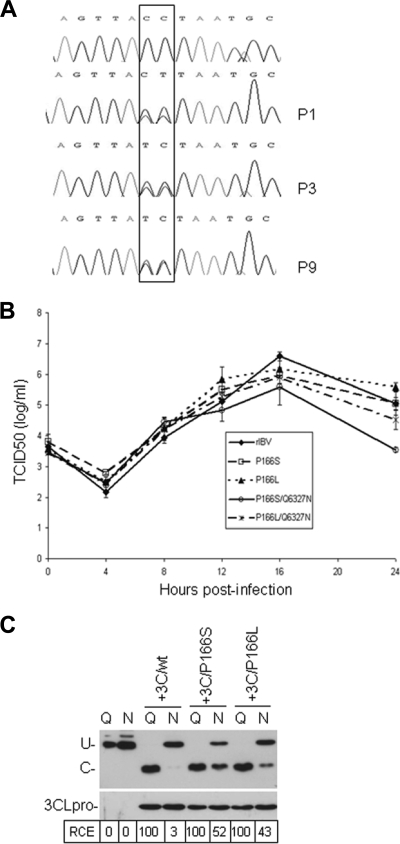FIG. 6.
Effects of a single amino acid mutation (P166S or P166L) in 3CLpro on the cleavage efficiency for the nsp15-16/Q6327N mutant substrate and IBV replication. (A) Existence of mixed nucleotides at nucleotide positions 9361 and 9362 in passage 1, 3, and 9 of the recovered double mutant viruses. Wild-type sequence in passage 6 of the recovered Q6327N mutant virus, which did not show syncytium formation, is shown on top. Viral RNA was extracted, and RT-PCR was performed. The purified RT-PCR products were directly sequenced. (B) Growth properties of mutant viruses. Vero cells were infected with the indicated viruses at an MOI of 1 PFU/cell and harvested at 0, 4, 8, 12, 16, and 24 h postinoculation. Viral stocks were prepared by freeze-thawing the cells three times, and the TCID50 of each viral stock was determined by infecting five wells of Vero cells on 96-well plates in triplicate with a 10-fold serial dilution of each viral stock. Error bar shows standard error of the mean. (C) Comparison of the cleavage efficiencies of wild-type (wt) and mutant 3CLpro at the nsp15-16 site containing the Q6327N mutation. Wild-type and mutant substrates were coexpressed with wild-type and mutant 3CLpro in H1299 cells using the vaccinia virus-T7 system. The transfected cell lysates were resolved on a 15% SDS-polyacrylamide gel and subjected to Western blotting with anti-Flag antibody. As a control, the amount of expressed 3CLpro was probed with anti-3CLpro antibody. The relative cleavage efficiency (RCE) is shown.

